Drying is the oldest and most commonly used method across various industries, drying process is essential across various industrial operations majorly food and chemical to remove moisture. The methods of drying in practice are
1. Under Sun drying, oldest method of naturally drying the food and related items
2. Hot air drying, one of the common drying method in which food item to be dried is exhibited to explosion of hot air
3. Electromagnetic based drying, application of new heating technologies such as infrared, Radio frequency and microwave
4. Freeze drying, frozen materials are positioned in a vacuum compartment to lure out the water
Most common application of drying technique in food industry comprises of dairy products, milk, whey, creamers, coffee, coffee surrogates, tea, flavours, powdered drinks, processed cereal-based foods, potatoes, starch derivatives, sugar beet pulp, fruits, vegetables, herbs and spices.
In the process of water removal (drying), water can be in three forms solid, liquid and vapour. The state in which it is at any time depends on the temperature and pressure.
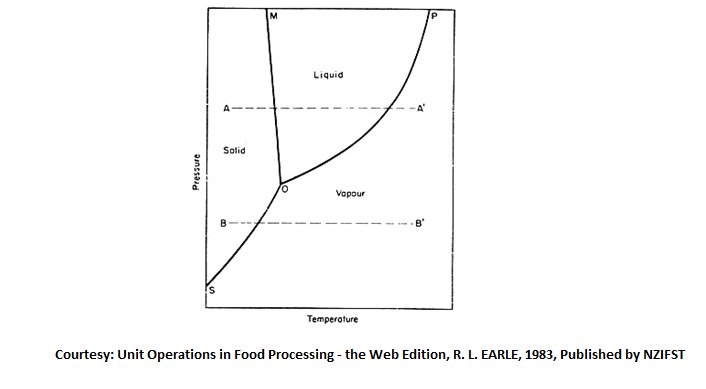
- Below are the types of dryers commonly used for drying of Food and related items:
- Tray Dryers
- Rotary Dryers
- Tunnel Dryers
- Trough Dryers
- Roller or Drum Dryers
- Bin Dryers
- Fluidized Bed Dryers
- Belt Dryers
- Spray Dryers
- Vacuum Dryers
- Pneumatic Dryers
- Freeze Dryers
Tray Dryers: Tray dryers typically function in batch mode, it comprises of racks to hold product, heating is attained by an air current circulating across the trays, by conduction from heated trays or heated shelves on which the trays lie, or by radiation from heated surfaces. Most tray dryers are heated by air, which also removes the moist vapours. Tray dryers are useful for the small production rate. These dryers are suitable for wide range of food items. Drying operation in case of tray dryers are slow and requires huge labor force for loading and unloading.
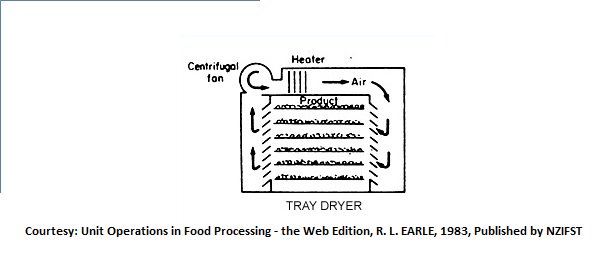
Tunnel Dryers: Tunnel dryers belongs to family of continuous drying process, in this material under treatment process travel in comportment, shaped as tunnel and hot air circulating this with in it. In most cases, air is used in tunnel drying and the material can move through the dryer either parallel or counter current to the air flow. Sometimes the dryers are compartmented, and cross-flow may also be used.
Roller or Drum Dryers: The rotary drier is essentially a cylinder, disposed marginally to the horizontal, which may be rotated, or the shell may be stationary, and an agitator inside may revolve slowly. In these the food is spread over the surface of a heated drum. The drum rotates, with the food being applied to the drum at one part of the cycle. The food remains on the drum surface for the greater part of the rotation, during which time the drying takes place, and is then scraped off. Drum drying may be regarded as conduction drying.

Fluidized Bed Dryers: In a fluidized bed dryer, the food material is maintained suspended against gravity in an upward-flowing air stream. There may also be a horizontal air flow helping to convey the food through the dryer. Heat is transferred from the air to the food material, mostly by convection.
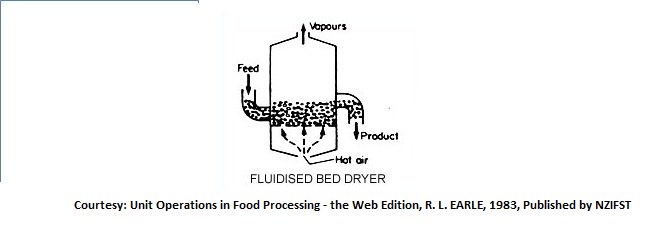
Spray Dryers: In a spray dryer, food item is dried until it achieves status. Air and solids may move in parallel or counterflow. Drying occurs very rapidly, so that this process is very useful for materials that are damaged by exposure to heat for any appreciable length of time. The dryer body is large so that the particles can settle, as they dry, without touching the walls on which they might otherwise stick. Commercial dryers can be very large of the order of 10 m diameter and 20 m high.
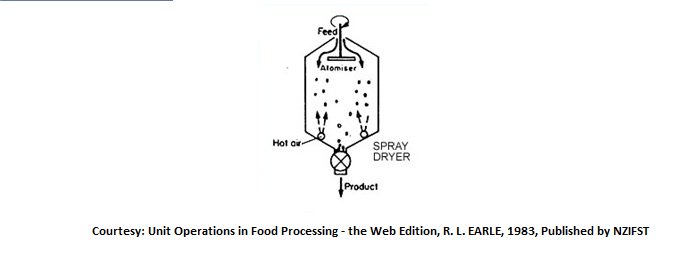
Pneumatic Dryers: In pneumatic conveying dryers the powders or granular materials are dried while suspended in a stream of heated air, the solid food particles are conveyed rapidly in an air stream, the velocity and turbulence of the stream maintaining the particles in suspension. In pneumatic dryers, powders or foods are continuously dried in vertical or horizontal metal ducts. A cyclone separator is used to remove the dried product. Some its used in collaboration with the spray dryers to provide second stage of drying.
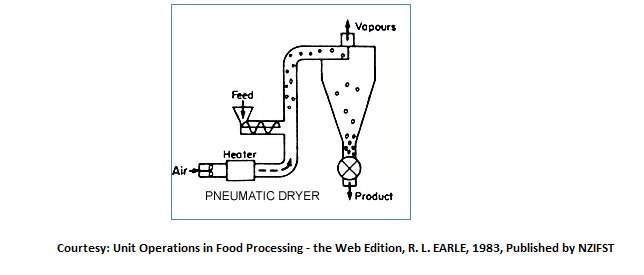
Rotary Dryers: The rotary drier is basically a cylinder, the food item is placed in horizontally inclined cylinder through which it passed, and heated by means of hot air or conduction of heat from walls. Cylinder might be rotational in nature of may be stationary. The food material is fed into cylinder from upper end and the rotation or agitation make food material travel gradually to lower end, where it gets cleared.
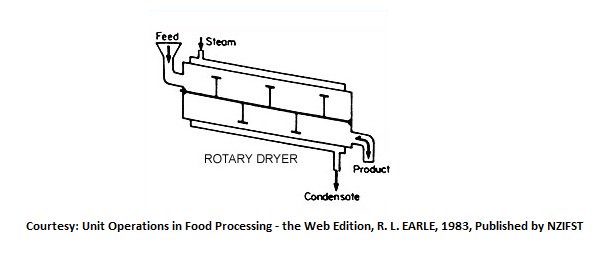
Trough Dryers: The materials to be dried are contained in a trough-shaped conveyor belt, made from mesh, and air is blown through the bed of material. The movement of the conveyor continually turns over the material, exposing fresh surfaces to the hot air.
literature: Unit Operations in Food Processing – the Web Edition, R. L. EARLE, 1983, Published by NZIFST
Bin Dryers: In bin dryers, the foodstuff is contained in a bin with a perforated bottom through which warm air is blown vertically upwards, passing through the material and so drying it.
(literature: Unit Operations in Food Processing – the Web Edition, R. L. EARLE, 1983, Published by NZIFST)
Belt Dryers: The food is spread as a thin layer on a horizontal mesh or solid belt and air passes through or over the material. In most cases the belt is moving, though in some designs the belt is stationary and the material is transported by scrapers.
(literature: Unit Operations in Food Processing – the Web Edition, R. L. EARLE, 1983, Published by NZIFST)
Vacuum Dryers: Batch vacuum dryers are substantially the same as tray dryers, except that they operate under a vacuum, and heat transfer is largely by conduction or by radiation. The trays are enclosed in a large cabinet, which is evacuated. The water vapour produced is generally condensed, so that the vacuum pumps have only to deal with non-condensible gases. Another type consists of an evacuated chamber containing a roller dryer.
(literature: Unit Operations in Food Processing – the Web Edition, R. L. EARLE, 1983, Published by NZIFST)
Freeze Dryers: The material is held on shelves or belts in a chamber that is under high vacuum. In most cases, the food is frozen before being loaded into the dryer. Heat is transferred to the food by conduction or radiation and the vapour is removed by vacuum pump and then condensed. In one process, given the name accelerated freeze drying, heat transfer is by conduction; sheets of expanded metal are inserted between the foodstuffs and heated plates to improve heat transfer to the uneven surfaces, and moisture removal. The pieces of food are shaped so as to present the largest possible flat surface to the expanded metal and the plates to obtain good heat transfer. A refrigerated condenser may be used to condense the water vapour.
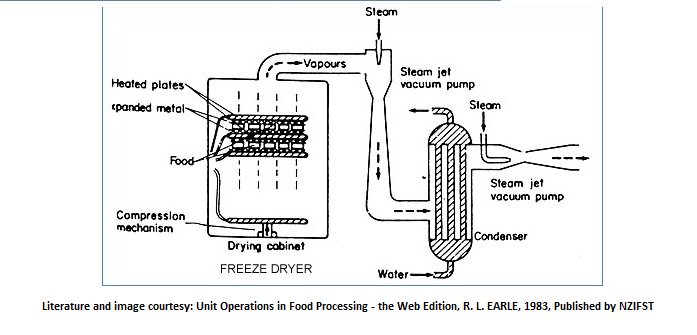
Dryers have been inseparable part of food and food related items processing systems, hence proper design and care always required while selection of suitable drying system, we at KERONE having more than 40 years’ experience in helping food industries to nurture by providing world-class drying solution. Our solutions are crafted by team of experts in our research centre, always endeavouring for better quality, better technology and more efficient solution, our commitment toward our clients had made us trusted choice of various industrial leader when it comes to engineering solution. If you are seeking any help feel free to reach us at info@kerone.com .
